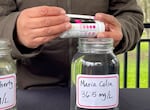
FILE: Gov. Tina Kotek, right, tours Boardman with local organization Oregon Rural Action on May 3.
Monica Samayoa / OPB
State officials say they have ramped up nitrate testing in Eastern Oregon, where longstanding groundwater pollution has contaminated residents’ wells. Their aim is to contact all domestic well users in the region by the end of September.
The Oregon Health Authority along with the Oregon Department of Human Services said Friday that the agencies have turned to door-to-door canvassing to increase domestic well testing in the Lower Umatilla Basin Groundwater Management Area. For more than 30 years, the region’s groundwater has been polluted with contaminates, primarily nitrates. Groundwater is the main source of drinking water for residents in the area.
Efforts have been made to address the issue, including the creation of a committee tasked with finding solutions, but nitrate levels have continued to increase, according to the Oregon Department of Environmental Quality.
OHA’s Gabriela Goldfarb said testing wells and providing bottled water are short-term solutions.
“We test for about six to seven different things,” she said, noting that the analysis can help the state decide if someone needs water treatment immediately.

FILE: Residents from Eastern Oregon and Oregon Rural Action held a press conference on Aril 17 demanding Gov. Tina Kotek declare a state of emergency.
Monica Samayoa / OPB
Goldfarb is the Lower Umatilla Basin Groundwater Management Area’s public health coordinator and the environmental public health section manager for the Oregon Health Authority.
Door-to-door canvassing started in mid-July to raise awareness of the contaminants and health issues associated with nitrates. The agency is also testing for E. coli bacteria, arsenic, lead, iron, manganese and calcium carbonate.
Previously, the agencies relied on residents to seek out and return vouchers to get their well tested.
“We saw that there were still a lot of barriers, even though we were offering free well tests,” Goldfarb said. “You had to apply for a voucher, you had to contact the lab to get a test kit, go and follow the instructions … . Month-by-month, we’ve been building additional systems to overcome those barriers.”
In Oregon, there are no state water quality regulations on domestic or private wells. Homeowners are responsible for testing their wells for contamination.
Earlier this year, Gov. Tina Kotek pledged to address the nitrate issue and has so far appointed a Spanish-speaking member to the committee tasked with finding solutions. She’s also allocated $6.2 million for the region that includes testing, outreach, and providing drinking water for households that need it. But local community organizations say more outreach and quicker testing is needed to meet the governor’s goal.
There are an estimated 4,500 domestic wells in Umatilla and Morrow counties that could be affected. As of Friday, 559 wells have been tested, with 28% of those testing at a level that makes it unsafe to cook with or drink. According to the Environmental Protection Agency, nitrate levels exceeding 10 milligrams per liter can cause serious health effects.
Of those households currently tested, 298 are receiving clean water deliveries, and 25 homes have water treatment systems installed. There are more than 600 households that received vouchers for testing, but have not completed the process.

Oregon Rural Action's Ana Maria Rodriguez conducts a rapid test on a jar of water brought from Boardman, Ore., which tested above the federal standard of 10 milligrams per liter.
Monica Samayoa / OPB
Goldfarb said although initial state testing started off slow, progress has been “amazing” so far. She said the Oregon Health Authority is also verifying where the wells are located, how many wells there are and which ones are connected to homes. She said it’s possible there could be more than the estimated 4,500 wells exposed, but there could also be a lot less than that.
“We’re still in the learning mode because, again, I think it’s pretty unprecedented in the country that we’re able to do this kind of direct public health action to get people safe water in this way,” she said.
Earlier this week, state agencies and local organizations involved in the nitrate issue, like Oregon Rural Action, held community forums in Morrow and Umatilla counties to explain the health impacts of drinking high levels of nitrates.
Zaira Sanchez, Oregon Rural Action’s director of community organizing, said so far, the coordinated effort has made a difference and it’s been good to see more state support. Still, Sanchez is concerned the September goal will not be met.
“After the governor came to Boardman and talked to the community members, we heard loud and clear that she was making a promise to the community to make sure that everyone would get a test, be tested and informed on this by the end of September,” Sanchez said. “I don’t think we are on track to make that promise a reality.”
Sanchez said there are still many homes that need to be tested on top of those that are currently waiting. Residents that have been tested are waiting for next steps as well, she said.
“A lot of people who are past that first step in short term solutions are ready for what’s going to happen next,” she said. “What does this mean for the next generations? What is it going to take to stop the contamination to really protect our health here in the Lower Umatilla Basin?”
Sanchez said residents are also eager to hear from the state epidemiologist assigned to gather information from people in the region who are suffering from illnesses that could be related to contaminated water. She hasn’t heard whether studies will begin soon.
“I have community members that are lined up, ready to share their stories, to do the analysis with these experts,” she said.
State agencies involved will continue to test wells in the region beyond September. Homes that tested at elevated nitrate levels will receive additional testing throughout the year. Water deliveries to affected households are also scheduled to continue until June 2025.
